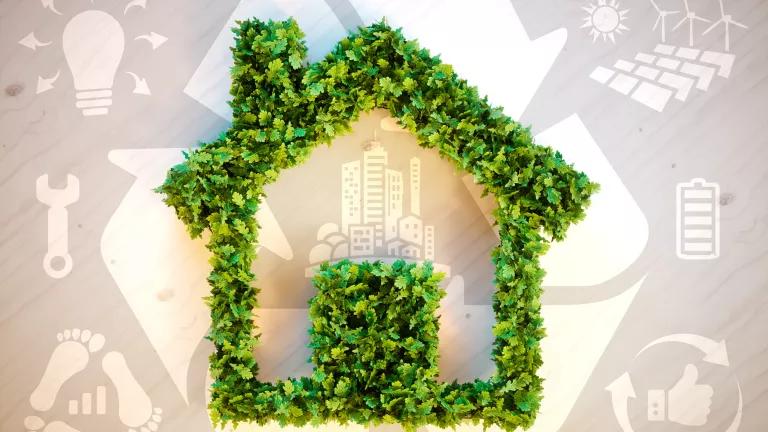Catalyzing Clean Energy Innovation
U.S. energy innovation has led the world for decades—but the urgency of climate change calls upon us to increase federal investment in clean energy innovation by at least two to three times, and to accelerate the pace at which we develop and deploy clean energy technologies.
That was a core message this week, which has been chock full of innovation-focused events, including three congressional hearings, a Politico event, and the release of a new report.
As we heard over and over again this week, addressing climate change will require the U.S. energy system to undergo dramatic changes, including the rapid deployment of clean energy sources, expansive electrification of buildings and vehicles, and shifts in how the industrial sector uses energy. These changes will challenge our energy system to meet energy demands in a reliable, equitable, and environmentally responsible manner. Clean energy innovation cuts the cost of this transformation, increases access to safer, more affordable, and more reliable clean energy technologies, and provides solutions to manage emerging problems facing our energy system. As was clear from the hearing held yesterday by the Senate Committee on Energy and Natural Resources, clean energy innovation is something that appeals to those on both sides of the aisle. Looking forward, federal leaders can support the clean energy transformation through a suite of smart and ambitious clean energy policies, including robust support for innovation, technology deployment incentives, and clean energy and carbon pollution performance standards.
Clean Energy Is Here and Now
Over the past decade, we’ve seen the payoff from nearly 40 years of federally funded research and development on clean energy. As a result, the clean electricity revolution is happening now—solar and wind are beginning to transform the power sector and will continue to do so. Large-scale solar plants and electricity from wind turbines have declined in cost by over 70 percent since 2008. Solar and wind are now the cheapest resources to generate electricity in some regions. Thanks in part to declining costs, wind capacity more than tripled in the last decade, and solar capacity increased almost 70-fold. These maps show how prevalent clean electricity has become across the country.
Innovation also helped slash the costs of LED lightbulbs—which typically use 75 to 80 percent less energy than their incandescent counterparts—by a whopping 94 percent since 2008, which means hundreds of millions of new bulbs have changed how we illuminate our buildings.
Clean energy is not a futuristic notion but rather a present reality. It already supports more than 3 million U.S. jobs for people of different skill sets and education levels. It also has become clear that clean energy can advance economic prosperity, environmental stewardship, AND energy security. Utilities’ commitments like those from Xcel Energy to eliminate carbon emissions from its power plants and from Southern Company to be low- to no-carbon—both by 2050—are just some of the many signals that fully embracing clean energy is not only necessary and doable, but also an accelerating trend increasingly backed by businesses.
Climate Urgency Requires Accelerating Innovation
Despite progress to date, there is still so much more to do. Renewable energy currently accounts for only 18 percent of our national electricity generation, though it has increased from 9 percent over the past decade. And while last year marked 1 million electric vehicles sold throughout the country (of more than 250 million cars on the road), several pathways for deep decarbonization of our economy would require electric vehicles to account for at least 90 percent of sales of new cars and trucks and 60 percent of miles traveled by the full light-duty fleet by 2050. That suggests the historic pace of innovation will need to accelerate going forward—the urgency to cut emissions and avoid the adverse impacts of climate change requires us to do so. We need to strengthen existing policies and put new ones in place to accelerate innovation.
The federal government can strengthen existing innovation programs in several ways:
Ensure long-term, stable, and predictable funding for innovation programs.
Thankfully, there has been strong bipartisan support in Congress for clean energy innovation despite proposals by the administration to make dramatic cuts to Department of Energy (DOE) funding. It is essential for Congress to continue defending existing DOE funding and—as recommended in the report released this week by the Energy Futures Initiative and IHS Markit—also increase funding levels to two to three times higher than current levels. We also call upon Congress and the Trump administration to implement dedicated funding sources for clean energy innovation that will ensure predictable and increasing levels of funding over a longer time horizon so that the innovation process is no longer subject to year-to-year budget uncertainty. In addition, we also note the importance of ensuring that the federal government is diligent about putting its appropriated funding to good use without delay—unlike what we have seen recently.
Pursue innovation across a wide range of technologies.
As outlined in an NRDC report, there is no single silver bullet to achieving deep decarbonization of our economy. Instead, it is about driving technological advances across all sectors, including power, transportation, and manufacturing. We need all technologies that can be pursued safely and without creating additional environmental or health hazards.
Prioritize technologies with the highest breakthrough potential.
While we advocate a diversified approach to innovation, that does not mean that equal attention should be given to all technologies. Instead, we believe the greatest focus should be placed on the following:
- Efficiency solutions for buildings, like high-efficiency heat pumps, organic LED light bulbs that can save energy in diverse lighting applications, and improved sensors and controls for building-to-grid integration;
- Renewable technologies breakthroughs, such as improved high-performance solar cells, analysis and tools to reduce the non-hardware costs of solar energy, and low-cost floating wind turbines;
- Energy storage technologies and grid modernization efforts, such as microgrid demonstration projects and longer-duration storage resources that can meet the needs of an evolving electricity grid;
- Vehicle efficiency and alternative fuel technologies, like lower-cost electric vehicle batteries, advanced materials to make vehicles lighter while maintaining safety, and more efficient freight trucks; and,
- Natural and technological solutions to pull carbon pollution from the air.
Invest in programs that bring innovation to peoples’ lives.
The programs that facilitate adoption and expand access to clean energy technologies are just as important as the research and development itself. For example, DOE funding supports job training programs for underrepresented communities to enter the solar workforce, award programs to lower permitting costs and open the market for solar adoption, and low-income energy efficiency programs that both build the market for innovative building technologies and expand access to cost-saving efficiency measures. These, too, are an important part of the innovation landscape and should not be forgotten.
Innovation Is One Critical Piece in a Larger Puzzle
While NRDC believes innovation has a key role in supporting the clean energy revolution, we also want to emphasize that bringing new technologies from the lab to the market requires more than just providing innovation funding upfront and then hoping the markets will do the rest. That is, robust innovation funding must also be accompanied by incentives to rapidly deploy clean technologies, and by performance- or market-based standards to better value the benefits of clean energy and to provide longer-term certainty to developers investing in clean energy resources.
In summary, the flurry of activity this week around innovation has spurred and advanced important conversations about how we can better harness clean energy innovation and complement it with other essential policies as we work to put our country on the path to a 100 percent clean energy economy with net-zero climate pollution by 2050.



